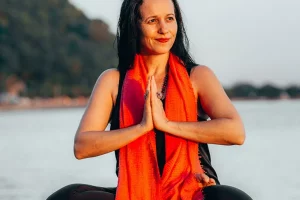Yama: Bringing Yoga Practice To Daily Life

Practising Yoga is about much more than the postures; the main practice goes on “off the mat” in our daily lives. Our thoughts, interactions with others, and our daily routines can all be integrated into the Yoga practice. Only this way the ultimate goal of this ancient system can be realised: bringing our bodies and minds into harmony and freeing us from the discomforts of everyday life.
The Yoga Sutra
Patanjali’s Yoga Sutra, written around 2500 years ago, was the first text to describe Yogic practices and remains one of the most influential Yoga texts to this day. In just 196 short sentences, Patanjali maps out a complete system of Yoga. The brevity is deliberate: each sentence requires the reader to think for themselves and develop a personal understanding of the practice. Patanjali understood that the only way to transmit spiritual knowledge is to invite a person to become their own teacher.
Yama
The Yoga Sutra breaks down the entire Yogic practice into 8 sections (known as the 8 Limbs of Yoga). The first of these limbs is called Yama, and explains how a practitioner of Yoga should conduct themselves in their daily life. It can be thought of as set of ethical standards, designed to encourage harmonious living with others. This is not to be confused with laws or social norms given by a particular society. Yama was traditionally seen as the foundation of Yoga, and was given to students before any further practice such as postures or meditation.
The Five Yamas
The Yoga Sutra breaks down Yama into five sub-sections:
1) Ahimsa (non-violence)
This means refraining from causing harm. Examples include vegetarianism or, in our modern age, living in a way that does not harm the environment. It is important to realise that this also refers to the harm we can do ourselves with the likes of destructive habits, negative thoughts and repressed emotions. Even pushing ourselves too far in a Yoga pose could be a form of violence against the self. Ahimsa is not a passive force; it is possible to radiate non-violent energy actively, bringing peace to others. People like Ghandi were able to bring about huge social change through the active force of non-violence.
2) Satya (truth)
We should pay attention to our speech and our thoughts to avoid becoming lost in illusion. The future and the past are only ideas in our minds and our perception of both can change depending on our mood or intentions – only in the present moment can the real truth be found. A person practicing Satya is not afraid to ask the question “Who Am I?”. In our modern society we define ourselves in many ways: through our relationships, our jobs, and our possessions. Really the truth is something else. While we may play the role of a husband or wife, teacher or student etc, these are transient labels that can distract us from realising our true selves.
Searching for truth can often be challenging and frightening process that involves letting go of many of the ideas and patterns we have built up over the years. For this reason many of us hide from the truth and prefer to dwell in the realm of distraction.
3) Asteya (not stealing)
The obvious interpretation of this is not taking possessions that do not belong to you, but in reality this Yama goes much deeper. Allowing, or approving of, others taking what is not freely given should also be avoided. Asteya can also relate to social justice: not partaking in oppression and exploitation of our fellow beings. Many occupations in modern society involve the exploitation of others for profit; a practitioner of Asteya would refrain from such work. We have all met people who seem to drain our energy or who try to use us for personal gain – this can be thought of as a form of theft. Damaging our environment is a form of stealing from future generations. We can also steal from ourselves; by exercising to the point of exhaustion or pushing ourselves too far in Yoga we are stealing our future well-being for short-term gain.
4) Brahmacharya (control of sexuality)
The Yogic tradition is not opposed to sexuality, in-fact it views sexual energy as one of the most powerful forces we have. However, sexual desire can totally overwhelm us if we are not careful. Yogis have developed techniques to divert this powerful energy away from every-day sexuality, instead using it for spiritual development, so many remained celibate (although traditions such as Tantra use sexual activities as part of spiritual practice). As we are increasingly exposed to an objectified form of sexuality in the form of advertising and entertainment, it seems more important than ever to gain control over this precious energy.
5) Aparigraha (non-possessiveness)
This relates to our attachment to external objects, which are viewed as temporary and unable to bring us lasting happiness. Practicing Aparigraha involves only possessing what is necessary and not being overcome by greed. We live in a society where we are encouraged to be obsessed with possessions, but the more we possess the more we become dependent on external things for our happiness and the more we desire new possessions. Rather than defining ourselves by the car we drive, the area in which we live, the gadgets we own or the clothes we wear, we should look within to understand our true essence. Even our bodies can be seen as an object which we become attached to, and we may use the gym or even Yoga classes to try make our appearance fit with social expectations. Even the body will not last forever, so a strong attachment to it will only bring pain.
Some Yogis would take Aparigraha to the extreme, forgoing all possessions except a bowl used to eat donated food. A less extreme approach would be to remain mindful that all possessions are temporary and do not define who we are.
Beyond The Yoga Mat
It is very beneficial to practice Yoga postures, and they can help us with many other aspects of the Yoga path (for example a more flexible body will allow for more comfortable meditation, and truthfulness and non-violence can certainly be practised during Yoga classes). However, we should bear in mind that the postures are only one aspect of Yoga – and we may only spend a few hours a week on the Yoga mat. The real work is done throughout our daily lives. By making Yama a foundational practice, we build a solid base for our spiritual development.




1 Comment